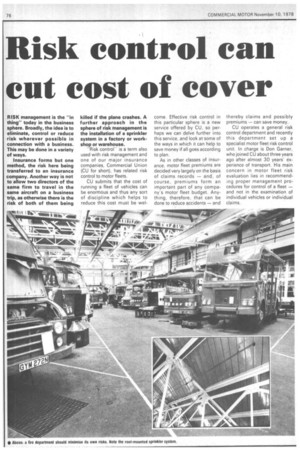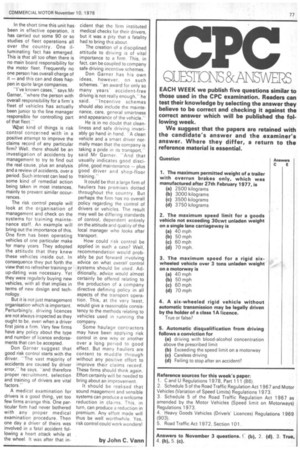Risk control can cut cost of cover
Page 80

Page 81

If you've noticed an error in this article please click here to report it so we can fix it.
RISK management is the "in thing" today in the business sphere. Broadly, the idea is to eliminate, control or reduce risk wherever possible in connection with a business. This may be done in a variety of ways.
Insurance forms but one method, the risk here being transferred to an insurance company. Another way is not to allow two directors of the same firm to travel in the same aircraft on a business trip, as otherwise there is the risk of both of them being killed if the plane crashes. A further approach in the sphere of risk management is the installation of a sprinkler system in a factory or workshop or warehouse.
"Risk control" is a term also used with risk management and one of our major insurance companies, Commercial Union CU for short), has related risk control to motor fleets.
CU submits that the cost of running a fleet of vehicles can be enormous and thus any sort of discipline which helps to reduce this cost must be wel come. Effective risk control in this particular sphere is a new service offered by CU, so perhaps we can delve further into this service, and look at some of the ways in which it can help to save money if all goes according to plan.
As in other classes of insurance, motor fleet premiums are decided very largely on the basis of claims records — and, of course, premiums form an important part of any company's motor fleet budget. Anything, therefore, that can be done to reduce accidents — and thereby claims and possibly premiums — can save money.
CU operates a general risk control department and recently this department set up a specialist motor fleet risk control unit. in charge is Don Garner, who joined CU about three years ago after almost 30 years' experience of transport. His main concern in motor fleet risk evaluation lies in recommending proper management procedures for control of a fleet — and not in the examination of individual vehicles or individual claims. In the short time this unit hasbeen in effective operation, it has carried out some 90 or so studies of fleet operations all over the country. One illuminating fact has emerged. This is that all too often there is no main board responsibility for the motor fleet. Frequently no one person has overall charge of it — and this can and does happen in quite large companies.
"I've known cases," says Mr Garner, "where the person with overall responsibility for a firm's fleet of vehicles has actually been junior to the line manager responsible for controlling part of that fleet."
Witat kind of things is risk control concerned with in a positive attempt to improve the claims record of any particular firm? Well, there should be an investigation of accidents by management to try to find out the real cause, plus an analysis and a review of accidents, over a period. Such interest can lead to some kind of remedial action being taken in most instances, mainly to prevent similar occurrences.
The risk control people will look at the organisation of management and check on the systems for training maintenance staff. An example will bring out the importance of this.
One firm has been operating vehicles of one particular make for many years. They adopted the attitude that they knew these vehicles inside out. In consequence they put forth the view that no refresher training or up-dating was necessary. Yet they were regularly buying new vehicles, with all that implies in terms of new design and technology.
But it is not just management organisation which is important.
Perturbingly, driving licences are not always inspected as they ought to be, even when a driver first joins a firm. Very few firms have any policy about the type and number of licence endorsements that can be accepted.
Don Garner suggest that good risk control starts with the driver. "The vast majority of accidents are caused by driver error," he says, "and therefore proper recruitment, selection and training of drivers are vital factors."
A medical examination for drivers is a good thing, yet too few firms arrange this. One par ticular firm had never bothered with any proper medical examination procedure. Then one day a driver of theirs was involved in a fatal accident fol lowing a heart attack while at the wheel. It was after that in cident that the firm instituted medical checks for their drivers, but it was a pity that a fatality had to bring this about.
The creation of a disciplined attitude to driving is of vital importance to a firm. This, in fact, can be coupled to company safe driving incentive schemes.
Don Garner has his own ideas, however, on such schemes. "an award for only so many years' accident-free driving is not really enough," he said. "Incentive schemes should also include the maintenance, care, general smartness and appearance of the vehicle."
He is in no doubt that cleanliness and safe driving invariably go hand in hand. "A clean vehicle and a smart driver normally mean that the company is taking a pride in its transport,'" said Mr Garner. "'And that usually indicates good discipline, good maintenance — plus good driver arid shop-floor training."
It could be that a large firm of hauliers has premises dotted throughout the country. But perhaps the firm has no overall policy regarding the control of drivers or vehicles. The result may well be differing standards of control, dependent entirely on the attitude and quality of the local manager who looks after transport.
How could risk control be applied in such a case? Well, recommendation would probably be put forward involving advice on what overall control systems should he used. Additionally, advice would almost certainly be offered relating to the production of a company directive defining policy in all aspects of the transport operation. This, at the very least, would give a reasonable consistency to the methods relating to vehicles used in running the company.
Some haulage contractors may have been applying risk control in one way or another over a long period to good effect. But many hauliers are content to muddle through without any positive effort to improve their claims record. These firms should think again. Effort certainly will be needed to bring about an improvement.
It should be realised that sound maagement and sensible systems can produce a welcome reduction in claims. This, in turn, can produce a reduction in premium. Any effort made will thus be well worthwhile Yes, risk control could work wonders!
by John C. Vann






















































































































































